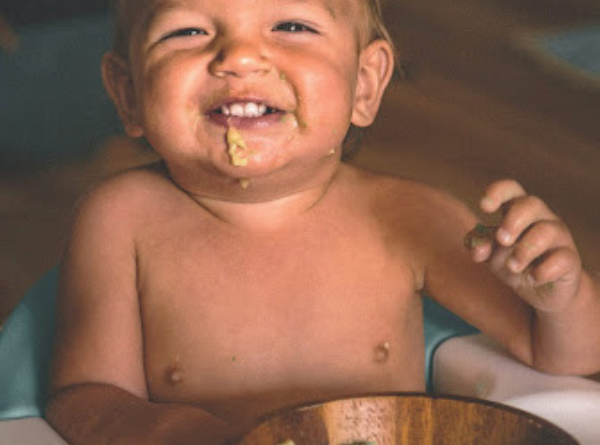Why ‘food before one is just for fun’ is not true
“Food before one is just for fun!”
Have you heard this phrase? It’s used with good intention I’m sure. I’ve heard ‘food before one is just for fun’ being used to reassure mums not to worry too much about weaning as it can be an anxiety-provoking time. We all want to do the best we can when it comes to starting solid foods with our little ones.
However recently, and rather, unfortunately, I’ve seen the phrase taken a little too far and in many of the Facebook forums, I can see ‘food before one is just for fun’ being used as a blanket ‘food doesn’t matter’ statement to dismiss parents’ concerns.
This worries me. Food can be fun and it really should be too, but it’s so much more than that. Food is needed for nutrition, for sensory development, for social interactions and ultimately, it’s needed so your baby can learn how to coordinate their whole body in order to learn how to eat.
This article contains affiliate links which means that if you choose to purchase a product by clicking on one of my links, the seller gives me a small amount of money but the cost to you remains the same. This money goes towards the running of this blog.

Baby Nutrition
After your little one is 6 months old, their nutritional needs are greater[1], so the food you offer requires a bit more thought and consideration. Their weaning journey is short. They have just 6 months to learn about food in order to arrive at family meals by the time they are 1 year old.
Breast and formula milk were an ideal nutrition source for the first 6 months but now they simply don’t contain enough nutrients for the rapid growth and brain development that occurs at this time. Have you noticed how a baby’s head is huge compared to the rest of their body? That is because most of the development in the first year of life happens in their brain. Not enough of the right nutrition during weaning can lead to learning and behavioural problems but getting nutrition right can enhance your baby’s intellectual abilities.[2]
At the start of weaning, when first feeding baby solid food, I recommend vegetables and fruit as first foods, but this stage shouldn’t last long. By 6.5 months nutrition becomes so important that I encourage parents to progress towards three meals a day so that by 7 months you have breakfast, lunch and dinner established.
These meals also need to consist of more than just vegetables and fruit. Protein foods like lentils, beans, meat, fish and dairy foods are necessary alongside energy boosting carbohydrate foods like potato, rice, pasta, bread, flour and other grains. These will provide the critical nutrients required in the second 6 months of your baby’s life.
I have a FREE Cheat Sheet you can download here on my favourite baby superfoods for weaning.
The critical nutrients that are most important at this stage are:

Iron
Babies nutritional requirements for iron skyrocket between 6 months and 2 years and it’s linked to their rapid brain growth. It’s also the most common nutritional deficiency seen in babies and toddlers. Babies who don’t get enough can be both sensory and cognitively impaired leading to learning issues. It can also affect their motor (muscles and balance) development and so really is a critical nutrient.[3]
Babies are born with iron stores that are laid down from their Mum in the last trimester of pregnancy but have been used up by six months of age. If your baby was born early or was low birth weight, their stores will likely have run out earlier.[4] Similarly, if you were iron deficient when you were pregnant your baby won’t have their full 6 months worth of iron.[5]
What this boils down to is that iron-rich foods need to be introduced quite early on in your baby’s weaning journey.
The best iron rich food source is red meat like beef, lamb or liver. I recommend that meat should be introduced as one of your baby’s first foods. Slow-cooked strips of beef or lamb are an easy to manage texture or minced beef made into meatballs or nuggets are ideal finger foods.
Other good sources of iron are egg yolks, dark poultry meat, fortified breakfast cereals and pulses like lentils and beans.
Spinach and other green leafy vegetables do contain iron but not as much as Popeye suggests! Dried fruits like raisins, sultanas and apricots are also good for iron and can be combined with other foods to make delicious baby food like lamb tagine, chicken with apricots or baked apples.
If your iron rich foods are non-meat, it’s a good idea to pair them with a vitamin C containing food as it helps your baby absorb the iron. Vitamin C is found in fruit and vegetables. I recommend that iron-rich foods are given twice a day from very early in weaning or if you are vegetarian, three times a day.
Incidentally, breast milk contains only a little iron but it is very well absorbed, and although infant formula is supplemented with lots of iron, it’s poorly absorbed by your baby’s body and is pooped out!
Omega 3 Or EPA And DHA
Omega 3 is an essential fatty acid. It’s called ‘essential’ because your baby’s body can’t make it and it can only be obtained through food.
Omega 3 or EPA and DHA are mainly found in oily fish. An alternative vegetarian form of omega 3 called ALA is found in walnuts, chia seeds, flaxseeds, sesame, rapeseed and edamame beans. However, ALA is poorly converted by the body so it’s difficult for babies to meet their nutritional needs from these sources.
You can also get omega 3 rich eggs which come from hens who have been fed an omega 3 rich diet.

Omega 3 is responsible for vision and healthy development of the eye and it is also essential for the growing brain. Babies who don’t get enough DHA can have affected vision, and there are suggestions it may affect cognitive abilities and intellect.[6]
Including oily fish in your baby’s weaning diet once or twice a week is the best way to guarantee enough DHA.
If you are breastfeeding, DHA passes through your breastmilk to your baby so breastfeeding mums should eat oily fish too![7]
Mums and girls shouldn’t eat more than 2 portions of oily fish per week but boys can have up to 4. This is because unfortunately, oily fish can also contain pollutants that build up in the body over time and may affect any unborn baby.[8]
I’ve written a detailed blog post on Omega 3 covering both the fish and vegetarian sources which you can access here.
Energy
Fats and oils are the most concentrated energy providing foods and despite their reputation for causing adults to become overweight, they are actually very healthy for babies. Babies should not follow a low-fat diet and it’s important to avoid ‘light’ or ‘diet’ versions of food.
Half of babies’ energy should come from fats and oils in order for enough calories for growth and development. Fats and oils are needed also for brain myelination[9] and a lack of it can affect cognitive development.[10]
Getting enough energy can be tricky as babies tummies are so small and their appetites can be variable, therefore it’s important to offer whole or full-fat versions of dairy foods like whole milk, cream, full-fat yoghurt and cheese and do cook with oil or use an olive-based spread wherever you can.
Don’t be afraid to add high-fat foods to your baby’s weaning diet. If they likes slices of peach, serve them with a pot of cream for them to dip them into. You can add melted butter to vegetables before serving and try sautéing, roasting and frying foods. Avocado and nut butters are great energy providers too. The best oils to cook with are rapeseed and olive oils as these are high in monounsaturated fatty acids which promote heart health.
Vitamin A
Vitamin A, also known as retinol, has lots of important functions in the body.
One of the key things it does is help your baby’s body develop a natural defence system against illness and infection (building their immune system). In addition, it’s also key for keeping her skin healthy and helping her have good vision.
Good sources of vitamin A include cheese, eggs, oily fish, milk and yoghurts and fortified spreads. If you are vegan focus on include sources of beta-carotene in the diet, which the body can change into Vitamin A. This can be found in spinach, carrots, mango and apricots.
Vitamin C
Vitamin C is a really important vitamin for your baby’s general health and boosting her immune system. In addition, as I mentioned earlier vitamin C can help her body absorb iron, so it’s a really good idea to serve iron rich foods with a source of Vitamin C. Good sources include oranges, kiwi fruit, strawberries, broccoli, tomatoes and peppers.
Vitamin D
The following section on vitamin D contains an affiliate link.
Vitamin D is not actually a vitamin, it’s a hormone and is naturally produced when sunlight hits the skin. Babies need this for bone strength and growth and it also plays a role in developing a healthy immune system.[11]
We can’t get enough vitamin D from food, the few foods that do contain vitamin D are oily fish, egg yolks and foods that have had vitamin D added during manufacturing like some margarine, some brands of milk and certain breakfast cereals. It’s recommended that babies between 6 months and 5 years take an 8.5mcg to 10mcg Vitamin D supplement each day in the first year of life.[12] Infant formula already contains the supplement so formula fed babies don’t need anything else if they’re taking more than 500ml a day but breastfed babies will need vitamin D drops.
There is also a recommendation for babies to be supplemented with vitamins A and C and so most baby drops also contain all three. My favourite baby vitamin is Nature and Nurture as it contains the recommended dose for all three vitamins and no additives or preservatives.
Download my FREE Cheat Sheet on my favourite baby superfoods for weaning.

Sensory Development
Learning to eat is the most complex sensory task that your baby has to do in their first year of life and it’s all managed and organised by the brain.
There are 32 different sensory steps that your baby must process for each and every food before it’s eaten.
There are eight (not five) different senses that coordinate with each other when your baby eats. They are:
- Visual (sight)
- Tactile (touch, textures)
- Auditory (sound)
- Olfactory (smell)
- Gustatory (taste)
- Proprioception (location/orientation of self in space e.g movement)
- Vestibular (balance and orientation of self in relation to gravity)
- Interoception (the ability to read and interpret internal bodily signal e.g feeling hunger)
Babies who have lots of opportunities to use their eight senses by exposure to lots of different foods have brains with a complex map of connections which improve their developmental skills, intellect and even influence behaviour! Food before one is NOT just for fun, it’s also critical for sensory development. You can read more about sensory weaning and find out exactly how to immerse your little one in sensory experiences in an article I wrote for Tidy Tot.
One of the most common senses that parents tell me they are worried about is taste – they are worried that their little ones will grow up to dislike the taste of food. These early exposures to a wide range of food helps your little one grow up to be less picky.
Research tells us that if your little one learns to like foods within a category such as vegetables or meat, they will become desensitized to other foods within that same category.[13]
Learning to eat
As well as providing nourishment for growth and development and mastering the 32 sensory steps to eating, there is a whole range of other skills that your baby needs to acquire in order to become a proficient eater. This starts with learning to move food around their mouth, chewing and swallowing. Then also how to pick up food with their whole fist, then in time with their pincer grip, directing the food to their mouth. There’s learning the use of a spoon and some babies will even be able to use a fork by their first birthday.
For the most this skill progression doesn’t require much effort on our behalf, babies will develop at their own rate if they are given the opportunity to learn however sometimes during this learning phase, other problems are identified like food allergies, oral motor delay or food aversions which is often when I’m called in to help. The mantra ‘food before one is just for fun’ isn’t right. Food is also for identifying problems early on so professionals can jump in and help out.
Window of opportunity
There are different developmental stages through weaning and we do see that little ones are more accepting of progressing through solids if these stages are taken advantage of. For instance bitter foods are better accepted around 4-6 months rather than introduced later, lumpier textures are best introduced by 9 months.[14]
If a little one does miss a window, all is not lost! It just takes a bit more work and support to help them get over their challenge.
Reducing the risk of allergies
Did you know that if you introduce the allergen foods before your little one turns one, this has a protective effect and actually helps to reduce the risk of an allergy? It’s true!
The advice is to introduce the allergenic foods, one at a time between 4 months and 12 months of age, alongside a normal weaning diet. Delaying introduction of these foods beyond 12 months can actually increase the likelihood of having an allergy.

Meal Planning
When planning your baby’s meals bear in mind the foods that contain those critical nutrients. To ensure the right balance follow my 4 step rule:
- Start with an iron-rich protein food like a lentil puree, ½ a boiled egg, some slow-cooked lamb or a minced beef meatball.
- Add a vitamin C rich food, for example, a broccoli floret or a couple of strawberries halved.
- Finish with an energy rich food like a soldier of buttered toast or sweet potato mashed with butter.
- Consider the range of colours, textures, smells. Have you got lots of different experiences for your baby?
Ideas for ‘food before one’:
Breakfast Ideas:
- Iron fortified breakfast cereals – there’s no need to buy baby cereals in fact often these are without iron.
- Scrambled egg and toast
- Porridge with pureed dried fruits
- Dippy eggs and buttered soldiers
- Eggy bread
- Peanut butter on wholemeal toast
I have a blog on this with 35 breakfast ideas!
Lunch / Dinner Ideas:
- Lentil and vegetable puree
- Chunks of salmon, avocado and toast
- Mini tuna sandwiches
- Slow cooked beef casserole
- Pasta Bolognese
- Beef chilli and rice
- Cottage pie
- Chicken and mushroom potato topped pie
- White fish in a cheese sauce
- Fish pie with a sweet potato mash
Snacks Ideas:
- Mini fruit muffin
- Hummus and breadsticks
- Homemade flapjack
- Crackers with cream cheese
I have a whole post on snack ideas, click here for inspiration!
Dessert Ideas:
- Custard
- Fruit and cream
- Homemade fruity milk jelly
- Yoghurt or fromage frais
- Pancakes and fruit
- Fruit juice ice lolly
Download my FREE Cheat Sheet on my favourite baby superfoods for weaning.

If you’d like to learn more….?
You can probably tell from my writing that I’m passionate about feeding babies and giving them the best start in life. I’ve compiled all my wisdom and expertise into one place, my Happy Healthy Weaning course which you can access from home night and day.
You’ll also get me 7 days a week in our community Facebook group to bounce ideas around with and answer your burning questions, saving you hours of internet trawling! Plus, it’s advice you really can trust.
I’d love to have you join me!

The post Why ‘food before one is just for fun’ is not true appeared first on The Children's Nutritionist.




